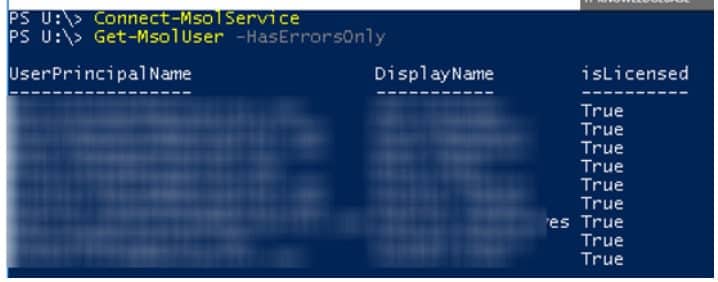
I recently encountered an issue on the Microsoft 365 admin center while checking the account Information of a user with archiving enabled. The user’s account properties pane displayed an error message at the top of the screen. The error message is as follows:
| Exchange: Failed to sync the ArchiveGuid 00000000-0000-0000-0000-000000000000 of mailbox 5d3475-987d-128b-8322b-803ujf33437c because one cloud archive ryb432303-f639-423e3-8edsb-1a9hebfyfd85 exists.; Exchange: An unknown error has occurred. Refer to correlation ID: 6bhrkmnr-7777-4a81-bf09-60jkfd376fba85; Exchange: An unknown error has occurred. Refer to correlation ID: 6b757fdfkld7777-4a81-bf09-6dshdeennrba85; Exchange: An unknown error has occurred. Refer to correlation ID: 6jdksjkds76bf-7777-4a81-bfskjds-6090ejkejba85 |
When users are synchronized from on-premises Active Directory to Entra ID, and either still have a local Exchange server or have decommissioned it, you might encounter issues with certain user account attributes. These attribute discrepancies can often be the root cause of these issues.
Fix Failed to Sync the ArchiveGuid Error
Launch PowerShell console as an administrator and execute the following commands:
Please note that even though MSOnline PowerShell module has been planned for deprecation, you can still follow the steps provided in this guide and fix the issue just by using ExchangeOnlineManagement PowerShell module as well. You can get the details about Archive GUID, Archive Name by using Get-Mailbox UserPrincipleName | FL Archive* command which is required for updating the user attributes in Active directory to fix this issue.
Note
# Install Exchange Online and MSOnline Powershell modules
Install-Module ExchangeOnlineManagement
Install-Module MSOnline# Import Exchange Online and MSOnline Powershell modules
Import-Module ExchangeOnlineManagement
Import-Module MSOnline# Connect to Exchange Online and MSOnline
Connect-ExchangeOnline
Connect-MsolService # List all the users with error
Get-Msoluser -HasErrorsOnly
- Check more information about the error for a particular user using below command. Replace [email protected] with the affected user’s UPN.
Get more details about the error
(Get-MsolUser -UserPrincipalName [email protected]).errors.errordetail.objecterrors.errorrecord | fl- Get the ArchiveGuid and the ArchiveName for the affected user. To do this, execute the following command (replace UserPrincipleName with the UserPrincipleName from the affected user).
Get ArchiveGuid and ArchiveName
Get-Mailbox UserPrincipleName | FL Archive* Alternative Command:
Get-MsolUser -HasErrorsOnly | select -ExpandProperty Userprincipalname | get-mailbox | ft Name, ArchiveGuid, ArchiveName
- Copy the ArchiveGuid value and execute the following command, replacing the ArchiveGuid with the value obtained previously. This command will convert the GUID to hexadecimal.
Convert the GUID to hexadecimal.
[system.guid]$guid = "ArchiveGuid" ($Guid.ToByteArray() | foreach { $_.ToString('x2') }) -Join ' 'Alternatively
- You can also use the below All in One command. This command will provide the UserName, ArchiveGUID, ArchiveGUID – HEX Value, and ArchiveName from the cloud mailbox.
Get-MsolUser -HasErrorsOnly | select -ExpandProperty Userprincipalname | get-mailbox | Select Name, ArchiveGuid, @{L='ArchiveGUID - HEXVALUE' ; expression={($_.ArchiveGuid.ToByteArray() | foreach {$_.ToString('x2') }) -Join ' '}}, ArchiveName
- Open Active Directory Users and Computers console. We will need to make 4 changes to each affected user account.
- User object > Properties > Attribute Editor If you do not see that option, you will need to enable Advanced Features from the View menu of Active directory users and computers snap-in.
| AD User Attributes | Set it to below values |
|---|---|
| mailNickname | Ensure that mailNickname is set. mailNickname is usually the same as everything before the @ symbol in the email address. |
| msExchArchiveGUID | Use the ArchiveGuid Hexadecimal Value and populate it in the msExchArchiveGUID. |
| msExchArchiveName | Use the ArchiveName value and populate it in the msExchArchiveName. |
| msExchRemoteRecipientType | Set it to 3 |
- Now, we will need to synchronize the changes to Entra ID using the Entra Connect server, either force a Delta sync using the following command or simply wait for 30 minutes.
Run delta sync
Start-ADSyncSyncCycle -PolicyType Delta- After you’ve fixed the AD user object for all affected users, run the below command again to verify and ensure that there are no users left with errors.
Verify If there are still users with Errors
Connect-MsolService
Get-MsolUser -HasErrorsOnly
Further Troubleshooting
If you still encounter the same error even after updating the attribute values and waiting for 30 minutes following the delta sync.
- Confirm that the mailNickName, mail, msExcharchiveguid, and msExchArchiveName attributes are syncing to Entra ID.
- Start an Initial synchronization to Entra ID using the command Start-ADSyncSyncCycle -PolicyType Initial to trigger a full synchronization. Please wait for the replication to complete and then recheck for the issue.

Great How-To, thank you for that!
Works!
You’r Welcome Marcel. I am glad that it helped.
Thanks for taking your time to create this document, it worked for me.
No Problem Marc. Thanks for the feedback.
I have tried so many of the other solutions but this one work for every step – thank you